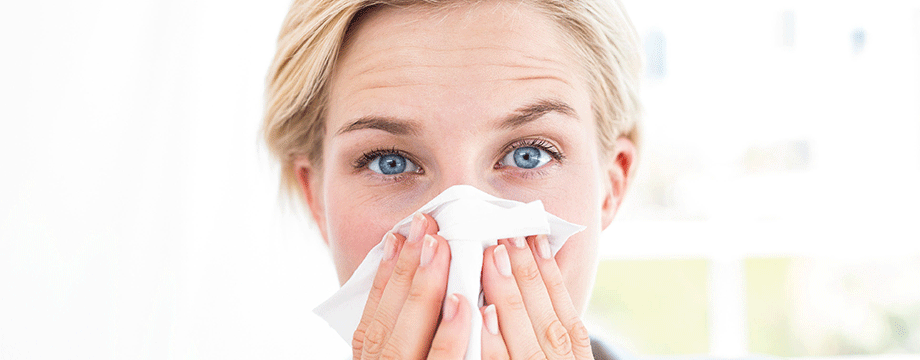Survive the summer

Facts, figures and top tips for combating hay fever
Spring is here and for many people that means one thing – hay fever season. Also known as seasonal rhinitis, the symptoms of hay fever range from sneezing and a runny nose to watery, itchy eyes and a blocked or stuffy nose. Hay fever occurs when the body produces allergic antibodies (IgE) in response to the pollen from grass, trees and weeds. Fortunately, you don’t need to suffer in silence as we’ve rounded up some of the best natural tips and tricks for combating hay fever, as well as some facts and figures that you might not know about...
The pollen season can start as early as January and end as late as November.
“Vitamin C is a natural antihistamine that is also excellent for the membranes lining your respiratory tract,” says Alison Cullen, nutritional therapist and education manager for A.Vogel (www.avogel.co.uk). “Tucking into plenty of fresh fruit and veggies will help keep your hay fever symptoms from swamping you.”
“An organic, drug-free allergen barrier balm can trap over a third of pollen particles before they enter the body where they can cause symptoms,” explains Max Wiseberg, airborne allergies expert, and creator of the HayMax allergen barrier balms (www.haymax.biz). Simply apply the balm to the nostrils and bones of the eyes.
If you suffer with the seasonal sniffles, drink plenty of nettle tea, as nettles have an antihistamine effect. “As caffeinated drinks such as coffee tend to cause inflammation, replacing them with herbal teas such as nettles, and plenty of still, plain water, will reduce the general level of inflammation in the body,” advises Alison Cullen.
“Eyebright is a very popular herb for all eye symptoms,” says Alison Cullen, “and will provide summertime protection against inflamed, itchy, dry or watery eye reactions. When taken internally as a tincture, it’s both anti-inflammatory and antiseptic for the eyes. Although taking Eyebright internally will benefit eye tissue generally, you will also find it available in the form of eye drops, which moisturise and calm inflamed eyes immediately.”
“Quercetin is thought to limit the release of histamine,” explains Max Wiseberg. “As well as being found naturally in many foods it can also be taken in a capsule. The recommended dose is 250-600mg per day, taken 5-10 minutes before meals.”
“Stabilising the immune system with regular doses of echinacea can be very helpful, especially if the problem is seasonal,” says Alison Cullen. “Take echinacea for two weeks prior to the usual appearance of the symptoms. Anti-inflammatory remedies such as devil’s claw can minimise symptoms, and many people find that herbal nasal sprays reduce their symptoms without causing any unpleasant side effects.”
95%... of hay fever sufferers are allergic to grass pollen, according to the NHS.
Gone vegan and feel better?
“Vegetarian/vegan diets tend to contain less arachidonic acid, which can form inflammatory chemicals that are likely to increase symptom severity,” says Alison Cullen. “Reducing the level of arachidonic acid by avoiding meat and dairy products can therefore ease your hay fever experience. Eating healthy sources of anti-inflammatory omega-3 essential fatty acids can also help: put avocados, walnuts, sunflower and pumpkin seeds on your menu.”
Roman chamomile is a natural hay fever treatment that could be worth exploring. “Roman chamomile (Chamaemelum nobile L.) is a unique medicinal herb with a long history of use,” explains Loukiani Chatzinasiou, product manager for Sibelius Ltd (www.sibeliusnaturalproducts.com). “It is frequently confused with the more well-known German chamomile (M. camomilla L.), which is commonly used as herbal tea. However, the therapeutic effects of Roman are considered to be better than those of German. Roman has been used traditionally for the treatment of various ailments, including respiratory inflammations, as well as applied anecdotally to relieve allergies, hay fever and asthma. Several compounds found in Roman have been previously reported to possess anti-inflammatory and anti-allergic activity, including azulenes and flavonoids.”
1 in 5 people are affected by hay fever.
According to the Met Office, the typical peak pollen hours are between 10am and 3pm, so staying indoors during these hours could help to reduce your symptoms during the height of the hay fever season.
“Oestrogen helps women control histamine, so menopausal women might find themselves suddenly far more sensitive, suffering hay fever for the first time or experiencing worse symptoms than usual,” says Alison Cullen. “Supporting their oestrogen levels by eating sources of fermented isoflavones (miso or tempeh, for example) could therefore benefit their hay fever symptoms as well as their menopausal symptoms.”
Read previous Your Health articles here...
Read articles from our latest issue here...